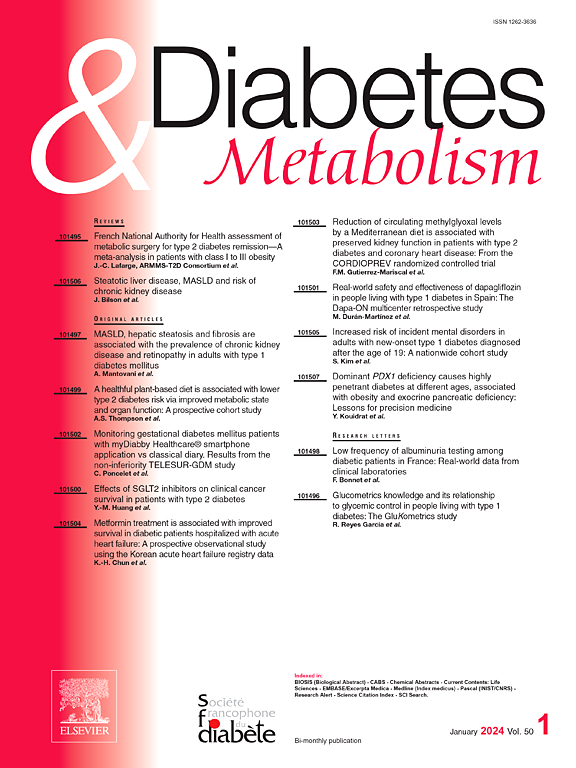Glycemia Risk Index (GRI) and international glucose targets before and 6 months after initiation of hybrid closed loop system in the CIRDIA, a French multisite out-of-hospital center
IF 4.7
2区 医学
Q1 ENDOCRINOLOGY & METABOLISM
引用次数: 0
Abstract
Aims
To analyze in a population of persons with type 1 diabetes (PwT1D) ambulatory glucose profile (AGP) parameters – including glycemia risk index (GRI) – for six months after hybrid closed loop (HCL) initiation in a multisite out-of-hospital French center (CIRDIA). We calculated the percentage of people reaching glucose targets and determined a GRI threshold that could identify patients reaching targets.
Methods
This was a retrospective study conducted in the CIRDIA, a multisite (n=7) out-of-hospital HCL initiation center. AGP metrics for the 14 previous days were manually extracted from HCL platforms at initiation (M0), 3 ± 1 months (M3) and 6 ± 1 months (M6). PwT1D were considered as reaching efficacy and safety targets (EST) if time-in-range was > 70 %, GMI was < 7 %, time-below-range (TBR)<70 was < 4 % and TBR<54 was < 1 %. GRI was calculated and ROC analyses were performed to set a GRI threshold that could identify patients reaching EST.
Results
Six-month data were available for 136 persons. The percentage of PwT1D reaching glucose targets at respectively M0, M3 and M6 were for EST: 6.6 %, 40.4 % and 39.7 %. GRI decreased from 56.0 ± 20.9 to 30.1 ± 14.1 and 30.6 ± 13.8. ROC analyses showed that the best GRI value to detect patients who reached EST was GRI <26. A threshold set at this level had very good specificity (92 %) and negative predictive value (93 %) to identify those who do need further intensive support with HCL.
Conclusion
Setting a GRI threshold at 26 could be helpful to detect with a single number, potentially automatically calculated by CGM platforms, PwT1D who require further support.
在CIRDIA(法国一家多站点院外中心)混合闭环系统启动前和启动后6个月血糖风险指数(GRI)和国际血糖指标
目的分析1型糖尿病(PwT1D)患者群体在混合闭环(HCL)开始后6个月的动态血糖谱(AGP)参数-包括血糖风险指数(GRI)。我们计算了达到血糖目标的人的百分比,并确定了可以识别达到目标的患者的GRI阈值。方法这是一项在CIRDIA进行的回顾性研究,CIRDIA是一个多站点(n=7)的院外HCL起始中心。在开始(M0)、3±1个月(M3)和6±1个月(M6)时,人工提取HCL平台前14天的AGP指标。如果时间范围为>,则认为PwT1D达到了疗效和安全性目标(EST);70%, GMI为<;7%,时间低于范围(TBR)<70 %;4%, TBR<;54为<;1%。计算GRI并进行ROC分析,设定GRI阈值,以识别达到est的患者。结果136例患者获得6个月的数据。EST在M0、M3和M6时,PwT1D达到葡萄糖目标的比例分别为6.6%、40.4%和39.7%。GRI由56.0±20.9降至30.1±14.1和30.6±13.8。ROC分析显示,GRI值为GRI <;26是检测EST患者的最佳GRI值。该水平的阈值具有非常好的特异性(92%)和阴性预测值(93%),以确定那些确实需要进一步强化HCL支持的患者。结论将GRI阈值设为26,可以通过单个数字进行检测,CGM平台可能会自动计算出需要进一步支持的PwT1D。
本文章由计算机程序翻译,如有差异,请以英文原文为准。
求助全文
约1分钟内获得全文
求助全文
来源期刊

Diabetes & metabolism
医学-内分泌学与代谢
CiteScore
12.00
自引率
4.20%
发文量
86
审稿时长
13 days
期刊介绍:
A high quality scientific journal with an international readership
Official publication of the SFD, Diabetes & Metabolism, publishes high-quality papers by leading teams, forming a close link between hospital and research units. Diabetes & Metabolism is published in English language and is indexed in all major databases with its impact factor constantly progressing.
Diabetes & Metabolism contains original articles, short reports and comprehensive reviews.
 求助内容:
求助内容: 应助结果提醒方式:
应助结果提醒方式:


